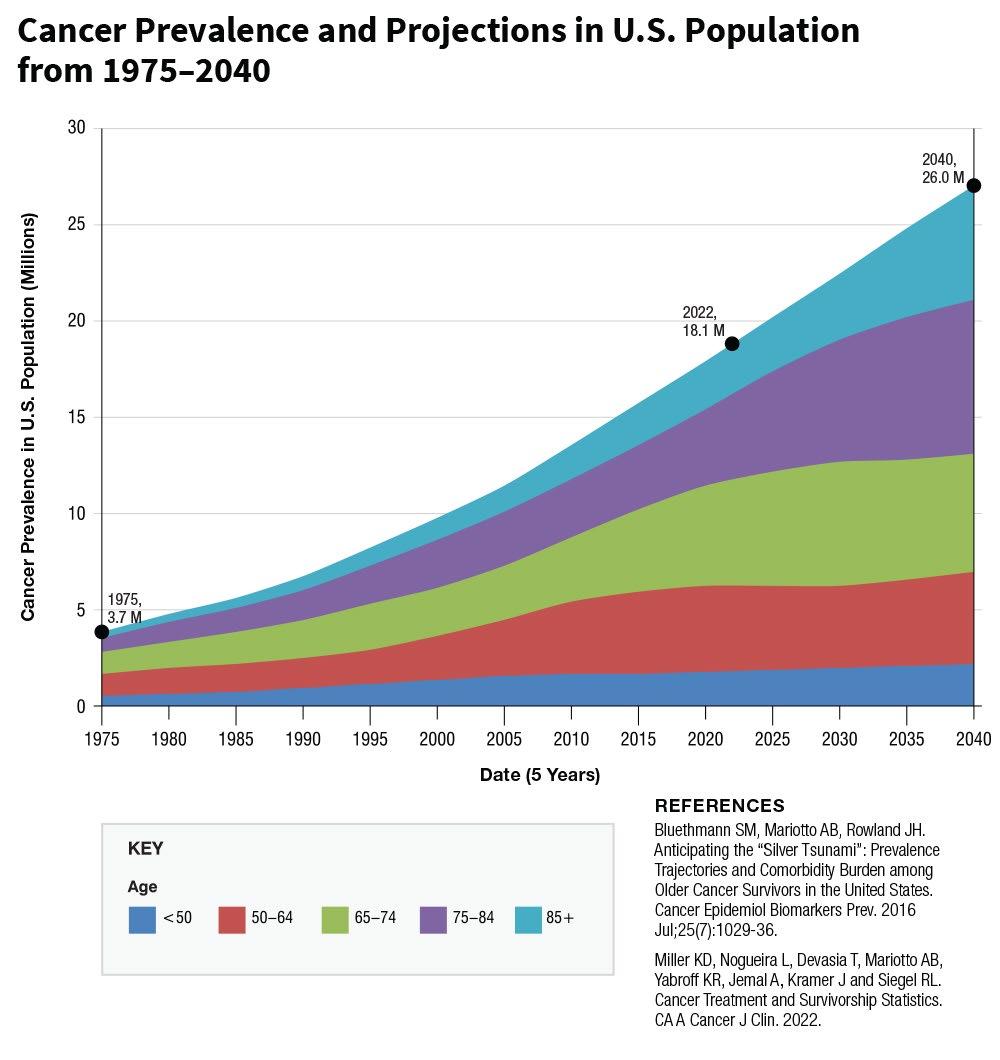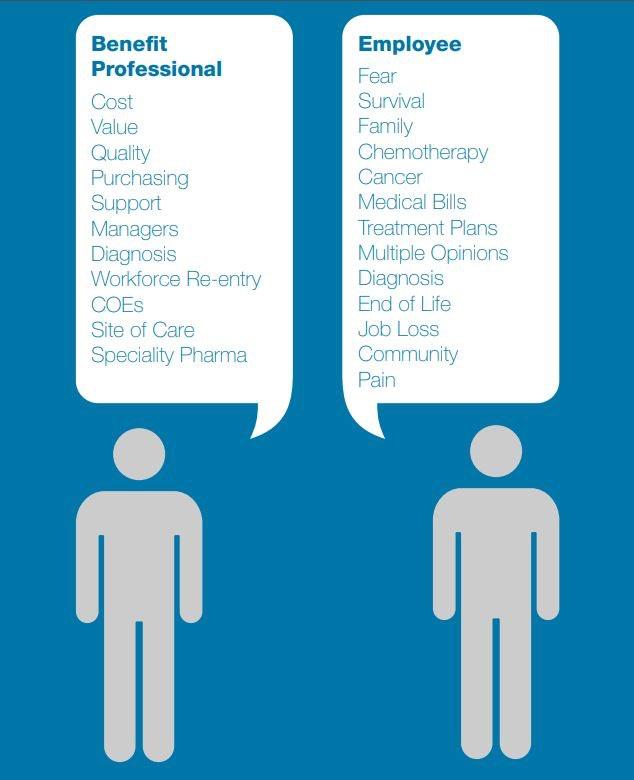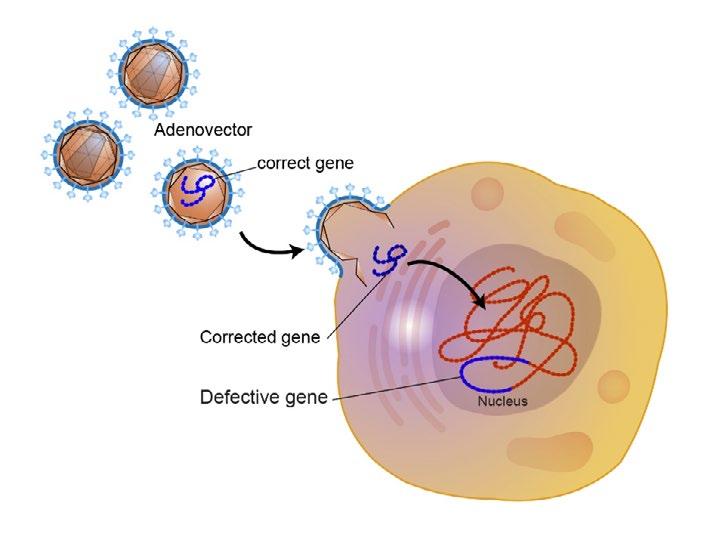
23 minute read
EASING THE COST IMPACT OF CANCER CARE
Written By Laura Carabello
Look around any workplace and it is likely that every employee knows someone who has been touched by cancer. Cancer rates are soaring, taking a toll on patients, survivors and their families, and impacting workforces in measurable ways such as productivity, absenteeism and presenteeism as well as the cost of health benefits.
This year, an estimated 1.9 million Americans will be diagnosed with cancer — up from 1.8 million in 2021, and the highest levels seen since 2007. The cost and financial impact to patients can be significant — as much as $21 billion a year, in both outof-pocket costs and time spent traveling to, waiting for, and receiving treatments. The lofty goals of the supercharged “Cancer Moonshot” announced recently calls for cutting the cancer death rate by at least 50% over the next 25 years, with many pinning their hopes on achieving these goals.
L
Looking back, however, oncology hasn’t been a top priority for benefits managers due to the complexity of care and related issues. But today, it has become a top concern. Results of a national survey of large employers reported in August 2022 show that oncology is now the biggest cost driver of employer healthcare benefits, nudging into first place ahead of musculoskeletal conditions which had previously held the lead position. Notably, 13% of those surveyed said they have seen more late-stage cancers and another 44% percent anticipate seeing an increase in the future, likely due to delays in screenings, and diagnoses because of health care closures related to the COVID-19 pandemic.
National Cancer Institute reports cancers that are diagnosed with the greatest frequency in the United States, excluding nonmelanoma skin cancers are:
• Bladder Cancer • Breast Cancer • Colon and Rectal Cancer • Endometrial Cancer • Kidney Cancer • Leukemia • Liver • Lung Cancer • Melanoma • Non-Hodgkin Lymphoma • Pancreatic Cancer • Prostate Cancer • Thyroid Cancer
Most common type of cancer is breast cancer followed by prostate cancer and lung cancer. Because colon and rectal cancers are often referred to as "colorectal cancers," these two cancer types are combined for the list.
SOME CANCERS MAY MORE PROBLEMATIC
Andy Szczotka, PharmD, chief pharmacy officer, AscellaHealth, shares this perspective, “All cancers are medical conditions that should be taken seriously. Cancers with the lowest five-year survival rates such as pancreatic, mesothelioma, gallbladder, liver and lung, are some examples of cancers that cause some of the greatest concerns. Additionally, cancers with the highest number of deaths, such as lung, colorectal and liver, are also of concern.”

Dr. Luke Burchard
There appears to be consensus that over the past several decades of medical progress, few advances can match the achievements made in cancer prevention, early detection and therapeutics in the United States. Luke Burchard, MD, MMM, DABFM, FAAFP, Medical Director, Avande, LLC, points out that the cancer death rate for men and women combined fell 32% from its peak in 1991 to 2019, the most recent year for which data were available.
“For the three most common cancers in men (prostate, lung and colorectal) and women (breast, lung and colorectal) most, if not all, cases can be either prevented, especially lung cancer by smoking cessation or detected early, especially breast, colon, and prostate cancer,” says Dr. Burchard. “It is strongly recommended that health plans include reimbursement for proven screening strategies such as mammography (breast cancer screening), colonoscopy, fecal occult blood, and fecal molecular/DNA testing (colo-rectal cancer), Prostate Specific Antigen (PSA) testing (prostate cancer), and chest CT scanning (lung cancer), as the bare minimum coverage for their members. Unfortunately, many of these screening tests were not performed during the Covid pandemic.”
“Genetic testing has moved well beyond basic testing such as the BRCA mutation,” emphasizes Dr. Burchard. After maintenance chemotherapy, breast cancer and prostate cancer are top “types” cancer by cost, according to Karin Landry, managing partner, Spring Consulting Group. She says, “Neoplasms make up approximately 13-15% of total costs and have been the top “condition” by cost for the past 3 years. But we have seen a steady increase, about 7-8%, for the past few years in the total cost of cancer.”

Some industry thought leaders advise that there are certain cancers that are more troublesome than others. Amy Tennis, vice president of Medical Management, MedWatch, advises,

Amy Tennis
“Breast, lymphomas and ovarian cancers can be problematic because of their aggressive nature and progression to specialty drugs, costly medications/ therapies, and in the case of lymphomas, high-cost transplants. All metastatic disease is particularly troublesome, and we are seeing a surge in these advanced disease states.”
She says that regardless of industry, the pandemic has thrown a bright spotlight on the need for early detection of cancers. While prior to 2019, early detection was key to reduce morbidity and the costs associated with treating cancers across the board, the delay of treatment associated with managing the pandemic has seen the incidence of cancers detected in later stages increase exponentially.
“As members delayed care and treatment during the onset of the pandemic, providers are seeing a surge of patients presenting for initial treatment of cancers in later stages,” says Tennis. “Patients diagnosed prior to the pandemic are also presenting with advanced disease due to treatment delays over the last two years, which may have been avoided had treatment not been delayed or avoided due to pandemic concerns.”
She cites these examples, according to Roundstone: Melanoma is 43x more expensive to treat at Stage IV ($42,303) than Stage 0 ($984). Breast Cancer Treatment per patient in the 12 months after diagnosis ranges from $60,637 at Stage 0 to $134,682 at Stage IV.
Dave McLean, PhD, CEO, Emerging Therapy Solutions, points to three cancers that are the most troublesome: pancreatic, glioblastoma and multiple myeloma. “This is because they are hard to treat and there are not many therapies available,” notes Dave. “Costs for these as well as other cancers have increased over the last two years as result of inflation and staffing expenditures related to COVID and new high-cost therapies.”
Dave McLean

Concurring that cost of care is directly related to a cancer diagnosis and treatment, Tatia Sheppard, chief clinical officer, Nova Healthcare Administrators, advises, “Effective communication and patient understanding are key to improved outcomes and avoidance of unnecessary services. Patients need constant reminders and reinforcement of expected side effects of treatment vs. when they should be concerned and contact their doctor. All this is overwhelming and complex.”
Medical Stop Loss from Berkshire Hathaway Specialty Insurance comes with a professional claims team committed to doing the right thing for our customers – and doing it fast. Our customers know they will be reimbursed rapidly and accurately – with the certainty you would expect from our formidable balance sheet and trusted brand. That’s a policy you can rely on.
Reimbursement done right.
www.bhspecialty.com/msl

Allison Johnson
She reports that patients who are wellinformed and have a good understanding of expected side effects will also know when an unexpected complication warrants a timely call to their provider, which will help avoid exacerbation of symptoms that may lead to higher cost services.
Additionally, Allison R. Johnson, president, Benefit Dynamics Company, cautions that health plans need to make sure they have a strong case management vendor in place that understands cancer protocols and standards of care. “We increasingly are seeing oncology treatment using chemotherapy drugs off- label,” says Johnson. “This can be prescribing drugs not approved for the specific diagnosis, or in dosages which are not proven effective.”
She advises that leaders consider certain options, including the advantages of Centers of Excellence for cancer care, or direct contracts with local oncologists or providers within the plan network. “Patient Navigators can help the patient navigate the plan offerings and steer them to appropriate providers,” says Johnson.
ESCALATING COSTS
In the years ahead, annual costs for cancer-related medical services and drugs in the U.S. are projected to reach $246B by 2030 — a 34% increase since 2015. For employers, oncology is among the top three spend categories for high-cost claimants, and while oncology accounts for only 1% of claims volumes, it comprises 15% of overall employer health care expenditures. Cancer is a complex disease and challenge individuals and families to identify highquality providers, manage care coordination and make multiple decisions regarding care and treatment. Employees often rely upon employers and their benefits professionals to assist at all levels.
Source: Cancer Workplace https://nebgh.org/wp-content/uploads/2015/10/CancerWorkplace_FINAL.pdf

Anthony Masotto, executive vice president of Drexi, says, “All cancers are troublesome and some have a much lower survival rate. I think early detection is critical not only in increasing survival rate but also decreasing the cost. We have seen a huge uptick in late-stage cancer for a variety of reasons. but I think most could be attributed to the lack of screenings over the past few years due to COVID.”
STRATEGIES TO LOWER THE COST OF CARE
Adhering to evidence-based guidelines in cancer care can lead to notable cost reductions, concluded researchers who studied the relationship between total cost of care and the use of National Comprehensive Cancer Network (NCCN) guidelines to direct care. They found savings among both breast cancer and colon cancer patients and found that using NCCN Guidelines® drove significant declines in total cost of care. NCCN Guidelines® are comprised of recommendations for the prevention, diagnosis, and management of malignancies across the continuum of care. The NCCN Guidelines® currently apply to more than 97% of cancers affecting patients in the United States.
Dr. Burchard raises a red flag about the costs of these ‘medical marvels,’ adding, “While it’s not possible to quantify the value of prolonged human life, the financial costs can be calculated and mitigated. New cancer therapeutics are costing over $100,000 per year per patient, and unfortunately, some institutions In his experience, the Company has identified two major health care systems in Indiana and Ohio that are charging up to 17 times their acquisition cost for certain chemo-therapeutic drugs, even though the nationwide average for price mark-up of such drugs ranges from 120% to 630%.
“Moreover, many hospitals can participate in the Federal 304b Drug Pricing Program that can save them an additional 20% of their usual acquisition cost for these medications,” he observes.

Looking ahead, Szczotka stresses that patient-centered care should be the focus for comprehensive cancer care and will lead to opportunities for coordinated programs that enhance patient outcomes and reduce overall health care expenditures. He points to some specific strategies for lowering the cost of care, including: “Application of Utilization Management programs such prior authorization, step care therapy, quantity limits and partial fill programs will have meaningful results,” says Szczotka. “We also foresee greater use of Benefit Maximum and Deductible programs and application of Rebate Management programs.”
He points to the growing importance of Specialty Pharmacy Networks which have specialty drugs dispensed and coordinated through identified specialty pharmacies to assist with enhanced pricing, minimizing waste by preventing excess drug accumulation, potential inappropriate dose escalation and ensuring appropriate dosing based on patient and drug specific parameters.
Szczotka also explains the increased utilization of copay assistance programs which improve the ability of the payer to make high-cost specialty and rare disease agents more affordable through their health benefits. He continues, “Alternative Funding Programs also provide means of access to philanthropic organizations, grants or other foundational programs that support access to high-cost therapies and shift the cost away from the patient and payer.” Landry cites Rx management as fundamental to controlling costs and recommends these strategies:
• Formulary Evaluation, Valued- based Limits, Clinical Outcome Payment • Medical Necessity and Prior Authorization • Co-Pay Accumulators • Discount Application Providers • Investing in Preventive Care and Wellness • Demand Price Transparency • Retail and Medical Pharmacy Strategy • Factor in Indirect Costs • Consider New Entrants • Importation
Looking ahead, next generation strategies are likely to include specialty carve outs that move specialty drugs away from traditional prescription drug management to a PBA or specialty administrator. These arrangements provide cost savings, remove any incentives to dispense product and present opportunities for management and control of the utilization management programs that align with payer expectations.
“Such programs also improve patient care coordination activities, with expanded opportunities to identify high-cost patients, predictively model potential high-cost patients and identify drivers of cost,” says Szczotka. “This approach serves to educate patients and provide opportunity to enhance patient adherence to therapy, identify non-adherence and proactively monitor patient adverse events. Programs can identify and mitigate barriers for continued patient compliance and symptom One area that is drawing significant concern is the identification of alternative Site of Care (SOC) Programs since lower cost sites of care can provide cost savings to the patient and payer. “Alternative sites may also be more convenient for patient and caregivers/ support team members,” says Szczotka.
Landry concurs, stressing that drugs that are dispensed in a hospital setting could potentially be moved to an office visit or even home-based treatment.
“Often changing the site of care can be more convenient to the patient as well,” she explains. “Carving out medical prescriptions is possible but can be disruptive for patients and therefore, is not typically desirable. The focus should be on net average cost vs. other medical alternatives for the clinical requirement of the individual. Savings projections also need to consider rebates and other fees or performance guarantees.
Masotto expands on this point emphasizing, “Cost will continue to rise if we don’t change how and where we get treatment. The number one money maker for hospitals is drugs to treat cancer patients and we see it every day and we need to carve out drugs from the hospital setting. If the diagnose is correct, then how and where they get their treatment should have the same outcome.”
He offers these examples: Patient #1: Diagnosis is Stage IV lung cancer and patient is put on six infusions of Optivo. The hospital charged the plan $53,614.56 per infusion, bringing the total to $321,687.36 which is 400% of the Medicare allowable rate. By carving out this drug to be filled through the PBM
Patient #2: Patient was prescribed Soliris (Eculizumab; generic name) a prescription medicine used to treat the symptoms of Paroxysmal Nocturnal Hemoglobinuria, Hemolytic Uremic Syndrome, Myasthenia Gravis, and Neuromyelitis Optica Spectrum Disorder. Approximate cost of a 20ml vial $8,000 which would give the patient four treatments. Another hospital practice is to break up the vial into four separate 5ml vials, repackage it and charge $10,000 per treatment. The group would be billed over $450K for the 12 month treatment. Again, using the PBM to the group’s advantage, this treatment would cost less than 100K sourcing the drugs through the PBM.
Masotto underscores the importance of getting a second opinion since too often, the diagnosis is incorrect, adding, “Make sure the plan is set up to not allow for the egregious practice by the hospital systems to take advantage of not only sick patients but also everyone within the plan. These behaviors have adverse effects on the medical cost, the stop loss cost and

the Rx cost, with all costs eventually passed on to plan members at no fault of their own.”
Tennis asserts that early detection through screening programs and aggressive Case Management with member participation is key. “Treatment in early stages provides better outcomes for the member and allows cost containment measures to be deployed early in the treatment regimen. Working with a Case Manager early in treatment allows network steerage, referrals to Centers of Excellence, and monitoring of the treatment program to ensure adherence to guidelines and standards of care, while also supporting the member and identification of costly gaps in care.”
She also stresses the role of stop-loss or reinsurance which looks for tight management of plan dollars in ensuring treatment guidelines and standards of care are followed to ensure seamless reimbursement of paid claims.
“MedWatch is instrumental in managing care to meet these requirements, and documenting adherence so that there are no questions regarding reinsurance coverage reimbursement or renewal issues,” she notes. “Reinsurance also wants to be informed of the case and on-going activity on an on-going basis on a case as soon as it is identified and throughout the case.”
Dr. Burchard expands upon these perspectives, citing the No Surprises Act (NSA) which was designed to force hospitals to publish their prices for chemo-therapy drugs, adding, “Unfortunately few have complied thus far. It is apparent that many factors will continue to provide cost containment challenges for self-insured employer groups and stop loss carriers. However, with aggressive prior-authorization protocols and relentless early detection and prevention strategies, it is still possible to provide the highest quality of cancer care and still contain the costs.
McLean echoes these perspectives, stressing the critical importance of early identification as a key driver of cost mitigation. He also recommends the use of genetic testing to better stage and treat cancers as a pathway to ensure that patients are getting to the right center for care with the right clinical protocols – NCCN or NCI as cited earlier. He also notes the importance of stop loss insurance for risk protection and expertise around cost containment and quality programs.
Underscoring the role of stop-loss insurance, Landry asserts that many of self-insured programs are looking at putting medical stop-loss into a captive, with a Spring survey reporting that although less than 50% of self-insured programs have stop-loss coverage, 42% of those that do have it within a captive.
“The largest concern when considering a self-funded program relates to the risk of the program being impacted by unexpectedly high claims – be it due to the volume of claims or due to the exposure to a handful of large loss claims,” says Landry. “One very sick individual or a series of unanticipated smaller claims could lead to a higherthan-expected claims level in a self-insured plan. Stop-loss insurance minimizes or eliminates this risk as well as dramatic fluctuations in claim costs over time, creating a level of predictability.”
Increases in late-stage cancer diagnoses since COVID have driven a higher priority on reducing the costs of cancer care, advises Rob Gelb, CEO of Valenz® Health.
“In 2022, we released enhanced care navigation with our Care Value Optimizer, matching members to solutions that offer greater predictability and control over these escalating costs,” says Gelb. “Our 501(r) network matches members living at or below 400% of the Federal Poverty Level with nonprofit hospitals that provide low- to no-cost cancer care; and we work with specialized Centers of Excellence to offer high-quality, pre-negotiated care at significant savings. These solutions benefit both the member and employer.”
FOCUS ON GENE AND CELL THERAPIES
Gene therapies are not simply another new class of specialty drugs to treat symptoms of a given disease -- they aim to cure by correcting the underlying genetic abnormalities causing the disease. With more than 900 investigational new drug (IND) applications for ongoing clinical studies of gene therapy products underway, and the FDA predicting they will be approving 10-20 gene therapies per year, the availability of these groundbreaking drugs is becoming an emerging driver of change in specialty pharmacy benefit management. But the significant benefits of gene therapies will not be realized unless patients have access to them, and the accompanying high price tags may be a significant deterrent for both employers and patients.
From Amy Tennis’ viewpoint, “Gene therapies are emerging treatments that show promise, and each will be more expensive than the one prior as they are proven effective. Funding these therapies will be a challenge for employers and stop-loss carriers going forward.”
While some therapies have shown positive results, she says more studies are needed. A cost vs. benefit analysis should be considered, as many are prohibitively priced with negligible benefit in outcomes.
You want unparalleled customer service. Employers need the right stop loss coverage. At Swiss Re Corporate Solutions, we deliver both. We combine cutting-edge risk knowledge with tech-driven solutions and a commitment to put our customers first. We make it easy to do business with us and relentlessly go above and beyond to make stop loss simpler, smarter, faster and better. We’re addressing industry inefficiencies and customer pain points, moving the industry forward – rethinking employer stop loss coverage with you in mind.
corporatesolutions.swissre.com/esl
Employer Stop Loss: Limit Health Care Exposure.
Advancing Self-funding Together.

Gene therapy is a type of highly targeted treatment that uses genetic material with the goal of changing the course of a disease. Most often, gene therapy works by introducing a healthy copy of a defective gene into the patient's cells. The idea is to modify the genetic information of the cell responsible for a disease, and then return that cell to normal conditions.
Source: The National Human Genome Research Institute, https://www.genome.gov/genetics-glossary/Gene-Therapy
Masotto would like to believe that technology will be able to cure a disease, "…but at what cost? Cancer treatment, mainly drug therapy, is big business for not only pharma but also for hospitals and health systems and unfortunately even things like gene therapies only work on certain people with specific DNA markers. Gene therapies are extremely expensive and have a low success rate because of all the things that have to be taken into account.”
The market entry of genetic therapies that represent new and potentially life-altering options for the people who use them represents steep costs as multi-million-dollar drugs have arrived. In fact, a new record was set recently when the FDA approved Zynteglo, a gene therapy for beta-thalassemia, a rare disorder requiring regular blood transfusions that carries a record $2.8 million price tag and making it the most expensive drug on a single-use basis in the U.S. and among the highest globally. Others such as Zolgensma which treats spinal muscular atrophy (SMA) cost $2.1 million for a one-dose treatment and Luxturna for genetic blindness runs $850,000. Szczotka points to the promising early data on the currently available gene therapies but says they have not yet fully demonstrated clinical cure for these patients.

“For example, the initial remission rate among patients treated with Kymriah® was about 85 percent with more than half the patients did not show relapses after a year,” notes
Szczotka who explains that Kymriah® is used to treat adults with certain types of B-cell non-Hodgkin lymphoma and people up to 25 years old with certain types of B-cell acute lymphoblastic leukemia. “Studies are planned to track outcomes of patients who received the therapy for 15 years to better understand and quantify the long-term effectiveness. Provenge®, used for prostate cancer in a 2020 retrospective study of 6,000 men, extended survival by nearly 15 months over traditional oral hormone therapy. While not providing a cure, these examples show improvements in the patient’s disease progression and may be an important addition to the treatment arsenal for appropriate patients.”
He further explains that while demonstrating improvements in their respective limited clinical studies, the gene therapy products come with unprecedented costs. “True value demonstration will be needed to help provide a value determination for these products,” he continues.
“Independent evaluations of gene therapy products from organizations such as ISPOR, the leading professional society for health economics and outcomes research globally and the
National Institute for Health and Care Excellence (NICE) will be needed to assist with value determination and reimbursement from various governmental sponsored programs and payers.”
He suggests that one mechanism for paying for these therapies is a Loan Based Assistance Program which converts the high upfront cost into a pay-over-time loan in small, predictable payments.
“These programs are also beneficial in that the sponsoring companies help protect the plan sponsor from therapeutic failures by use of drug product warranty and/or value-based agreements to have objective metrics in place to assist with the quantification of gene therapy success with the respective pharmaceutical manufacturer,” explains Szczotka. “This helps minimize the risk and cost to the payer for a treatment failure.”
McLean asserts that although the upfront cost of cell therapies is significant, as therapies become available earlier in the clinical pathway, this will become a more cost-effective option with better outcomes. “For instance, a very hard cancer to treat is multiple myeloma,” he explains. “At this time, they are a fifth line of treatment, so risk-takers have paid hundreds of thousands of dollars to treat the member by the time they qualify for CAR-T. Once they receive the CAR-T they have much higher chance of having a positive outcome, so moving this up in line will save the cost of other chemotherapies as well as potentially bone marrow transplant.”
Landry predicts that gene therapies will grow exponentially over the coming five years and will become a major spend item for insurers and self-insured employers.

“At a basic level, gene therapy uses sections of DNA to introduce genetic material into cells to treat or prevent disease,” she explains. “The genetic material contains a functioning gene which corrects the effect of the diseasecausing mutation. Due to the targeted nature, gene therapy offers great promise for treatment of diseases from Alzheimer’s to Parkinson’s, but the cost to the healthcare system may not be sustainable.”
She also says that while gene therapies are already expensive, “The Food and Drug Administration (FDA) is expected to approve 50 to 100 gene and cell therapies by 2025, by which costs could exceed $13 billion. In addition, as gene therapies migrate from treating rare to common conditions, demand, usage and expected coverage will grow considerably. Gene therapies are an example of when an additional discount negotiation or pooling may make sense.”
A FINAL WORD: GENOMIC TESTING
The scope of advanced genomic testing, which is designed to help identify the DNA alterations that may be attributing to the growth of a certain tumors, is expanding. Sheppard believes that precision cancer care is evolving rapidly, and advanced genomic testing is not necessary for every patient, explaining, “However, in certain situations, having more specific information about genomic mutations that are unique to an individual’s cancer can be beneficial in helping providers develop a more targeted treatment to address the identified mutations.” By looking at the tumor’s profile with genomic testing, physicians may be able to recommend a drug or protocol not previously considered, allowing them to offer more precise therapy, which improves patient outcomes and eliminates waste.
Sheppard continues, “There is more evidence of the benefits to identify better ways to detect, treat, and prevent cancer in people who carry genetic variants that increase the risk of certain cancers. Ongoing research and advances continue at a rapid rate
In some situations, Sheppard says this can attribute to cost savings and improved outcomes avoiding the “trial and error” approach, as a more refined treatment regimen can be administered. She points out that the testing cost does vary, and they can be costly. However, the cost associated with testing that can refine treatment approach is worth the investment.
“Additionally, there are misconceptions about genetic testing, lack of knowledge and understanding regarding the benefits of some testing – some of which include that results are not useful in making healthcare decisions and will not provide useful information about complex diseases,” concludes Sheppard. “Some believe testing is for understanding of ancestry only.” Tatia Sheppard

Laura Carabello holds a degree in Journalism from the Newhouse School of Communications at Syracuse University, is a recognized expert in medical travel, and is a widely published writer on healthcare issues. She is a Principal at CPR Strategic Marketing Communications. www.cpronline.com
Sources
https://www.cancer.org/research/cancer-facts-statistics/all-cancer-facts-figures/cancer-facts-figures-2022.html#:~:text=The%20Facts%20 &%20Figures%20annual%20report,deaths%20in%20the%20United%20States.)
https://healthactioncouncil.org/getmedia/0f6eb427-7d56-4bc9-9c58-7475ace4d46e/2022-UHC_HAC_WhitePaper-Costly-Conditions_ FINAL
https://www.benefitspro.com/2022/08/31/as-cancer-costs-rise-employers-looking-to-centers-of-excellence-bundled-payments/
https://abcnews.go.com/Health/million-cases-cancer-diagnosed-2022-report/story?id=82204749
https://www.fiercehealthcare.com/payers/cvs-study-using-evidence-based-guidelines-may-decrease-total-cost-cancer-care
https://www.aacr.org/about-the-aacr/newsroom/news-releases/cancer-care-costs-in-the-united-states-are-projected-to-exceed-245-billionby-2030/
https://nebgh.org/wp-content/uploads/2015/10/CancerWorkplace_FINAL.pdf
https://www.cancer.gov/types/common-cancers#:~:text=The%20most%20common%20type%20of,prostate%20cancer%20and%20 lung%20cancer
https://www.google.com/search?q=National+Comprehensive+Cancer+Network+(NCCN)+guidelines+to+direct+care.&rlz=1C1CHBF_en US850US850&oq=National+Comprehensive+Cancer+Network+(NCCN)+guidelines+to+direct+care.&aqs=chrome..69i57.5674j0j4&sou rceid=chrome&ie=UTF-8#:~:text=The%20NCCN%20Clinical,of%20Guidelines%20%2D%20NCCN
2022 Cancer Facts and Figures, American Cancer Society JAMA Oncology 2022;8(6):835-844 Published Online April 21, 2022. JAMA Oncology 2022;8(6):871-878 Published Online April 14, 2022. JAMA Internal Medicine 2022;182(6):603-611 Published Online April 18, 2022.





